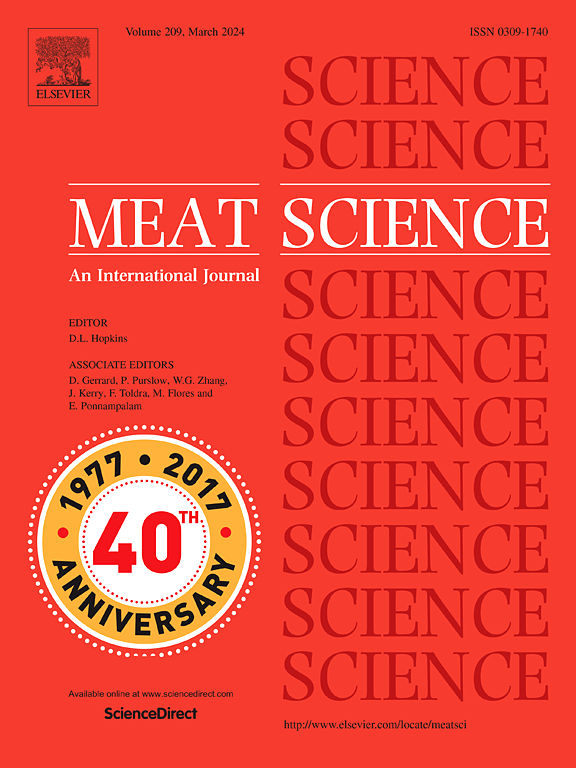在羔羊育肥期饲粮中替代lasalacid钠的baratim树皮:胴体特性和肉品质
IF 6.1
1区 农林科学
Q1 Agricultural and Biological Sciences
引用次数: 0
摘要
本试验旨在评价用山菖蒲树皮添加剂替代lasalocid钠对饲粮高精料羔羊胴体特性和肉品质的影响。选取24只初始体重为21.2±3.6 kg的pananeiro羔羊,采用随机区组设计,分为3个处理:1.50 g/只/d的干巴巴拉姆本文章由计算机程序翻译,如有差异,请以英文原文为准。
Barbatimão bark as an alternative to sodium lasalocid in finishing diets for lambs: Carcass characteristics and meat quality
This study aimed to evaluate the effects of replacing sodium lasalocid with additives from barbatimão bark (Stryphnodendron rotundifolium) on the carcass characteristics and meat quality of feedlot lambs fed a high-concentrate diet. Twenty-four Pantaneiro lambs with an initial body weight of 21.2 ± 3.6 kg, were distributed in a randomized block design with three treatments: 1.50 g/lamb/day of dried barbatimão bark (DBB); 0.30 g/lamb/day of hydroalcoholic extract of barbatimão bark (HEB); and 0.019 g/lamb/day of sodium lasalocid (LAS). Carcass characteristics were not influenced (P > 0.05) by the treatments, except for the degree of fattening (P = 0.01) where LAS showed higher values than HEB, but similar to DBB. The yellowness and hue angle values of LAS and DBB were higher than those of HEB (P < 0.05). The crude protein content of the meat decreased (P = 0.01) with the inclusion of barbatimão bark additives. Barbatimão bark additives show potential as a natural alternative to sodium lasalocid in lamb diets, as they do not negatively affect carcass characteristics. Although there was a reduction in the crude protein content of the meat with the use of barbatimão bark additives, this impact did not reduce meat quality.
求助全文
通过发布文献求助,成功后即可免费获取论文全文。
去求助
来源期刊

Meat Science
工程技术-食品科技
CiteScore
12.60
自引率
9.90%
发文量
282
审稿时长
60 days
期刊介绍:
The aim of Meat Science is to serve as a suitable platform for the dissemination of interdisciplinary and international knowledge on all factors influencing the properties of meat. While the journal primarily focuses on the flesh of mammals, contributions related to poultry will be considered if they enhance the overall understanding of the relationship between muscle nature and meat quality post mortem. Additionally, papers on large birds (e.g., emus, ostriches) as well as wild-captured mammals and crocodiles will be welcomed.
 求助内容:
求助内容: 应助结果提醒方式:
应助结果提醒方式:


